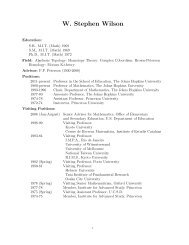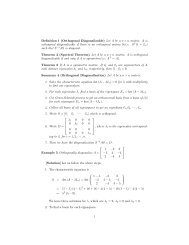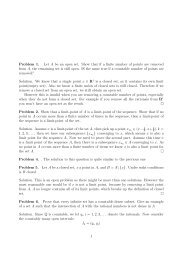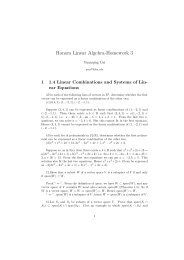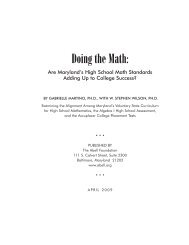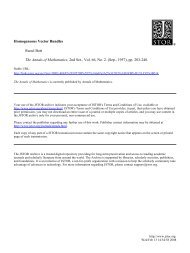Lecture 10: 4.2: Maximum and minimum values. Def. A function f ...
Lecture 10: 4.2: Maximum and minimum values. Def. A function f ...
Lecture 10: 4.2: Maximum and minimum values. Def. A function f ...
You also want an ePaper? Increase the reach of your titles
YUMPU automatically turns print PDFs into web optimized ePapers that Google loves.
<strong>Lecture</strong> <strong>10</strong>: <strong>4.2</strong>: <strong>Maximum</strong> <strong>and</strong> <strong>minimum</strong> <strong>values</strong>.<br />
<strong>Def</strong>. A <strong>function</strong> f : R n → R has a local maximum at a if f(x) ≤ f(a) when x<br />
is near a. Similarly, f has a local <strong>minimum</strong> at a if f(x)≥f(a) when x is near a.<br />
If the inequalities hold for all x in the domain of f then it is also a global (or<br />
absolute) maximum respectively global (or absolute) <strong>minimum</strong>.<br />
By a local extremum we mean a local maximum or <strong>minimum</strong>.<br />
Th. If f has as a maximum or <strong>minimum</strong> at a then Df(a) = 0.<br />
Pf. If f has a local max or min at a then for h the <strong>function</strong> g(t)=f(a + th) has a<br />
local max or min at t = 0, so g ′ (0)=0. By the chain rule we have<br />
Hence<br />
g ′ (t) = d<br />
f(a + th) = Df(a + th)h = ∇f(a + th) · h<br />
dt<br />
0 = g ′ (0) = ∇f(a) · h = fx1 (a)h1 + · · · + fxn (a)hn<br />
Since h=(h1, . . . , hn) is arbitrary it follows that fx1(a)= · · · =fxn(a)=0.<br />
<strong>Def</strong>. A point a is called a critical point of f if Df(a) = 0.<br />
The geometric interpretation of the conclusion of the theorem in R 2 is that the<br />
tangent plane to the surface z =f(x, y) at (a, b) is horizontal.<br />
By the above theorem a local maximum or local <strong>minimum</strong> has to be a critical point.<br />
However, not all critical points are local maximum or <strong>minimum</strong>. For <strong>function</strong>s of<br />
one variable take e.g. f(x) = x 3 at x = 0.<br />
How do we know if a critical point is an extreme value? For <strong>function</strong>s of one<br />
variable, if f ′ (a) = 0 <strong>and</strong> f ′′ (a) > 0 then it is a min <strong>and</strong> if f ′′ (a) < 0 then it is a max<br />
<strong>and</strong> if f ′′ (a) = 0 then it could be either or neither. What would the corresponding<br />
condition be in higher dimensions? Recall that by Taylor’s formula if Df(a) = 0<br />
f(a + h) − f(a) = 1<br />
2 hT Hf(a)h + R2(a, h), where |R2(a, h)| ≤ M∥h∥ 3<br />
where Hf = {∂xi ∂xj f}i,j=1,...,n is the Hessian matrix of second derivatives of f.<br />
The term with the Hessian is a quadric form Q in h, i.e. for some constants bij:<br />
Q(h) = h T Bh = ∑<br />
i,j=1,...,n<br />
bijhihj<br />
<strong>Def</strong> A quadratic form is called positive definite if Q(h) > 0, for all h ̸= 0 <strong>and</strong><br />
negative definite if Q(h) > 0, for all h ̸= 0.<br />
Th (Second derivative test) Suppose that f :R n →R has a critical point at a.<br />
(1) If the Hessian Hf(a) is positive definite then f a local min at a.<br />
(2) If the Hessian Hf(a) is negative definite then f a local max at a.<br />
(3) If det Hf(a) ̸= 0 but neither (1) nor (2) hold then f has a saddle point at a.<br />
Th. (The second derivative test for <strong>function</strong>s of two variables) Suppose<br />
that (a, b) is a critical point <strong>and</strong><br />
D = fxx(a, y)fyy(a, b) − fxy(a, b) 2 .<br />
If D > 0 <strong>and</strong> fxx(a, y) > 0 then f(a, b) is a local <strong>minimum</strong>.<br />
If D > 0 <strong>and</strong> fxx(a, y) < 0 then f(a, b) is a local maximum.<br />
If D < 0 then f(a, b) is a not a local <strong>minimum</strong> or maximum.<br />
1
2<br />
If D = 0 then the test is inconclusive.<br />
Proof To prove the first statement we have to show that the symmetric quadratic<br />
form ax 2 + by 2 + (c + d)xy is positive definite if a > 0 <strong>and</strong> ab − cd > 0, where c = d.<br />
Completing the square we get<br />
ax 2 + by 2 + 2cxy = a(x 2 + 2xyc/a + y 2 b/a) = a ( (x + yc/a) 2 + y 2 (b/a − c 2 /a 2 ) ) > 0<br />
for all (x, y) ̸= (0, 0) if a > 0 <strong>and</strong> ba − c 2 > 0.<br />
The case D < 0 is called a saddle point. To remember the formula:<br />
fxxfyy − f 2 �<br />
�<br />
xy = �<br />
� fxx fxy<br />
fxy fyy<br />
Ex. Find the critical points of f(x, y) = x 2 + y 2 . Are they extreme <strong>values</strong>?<br />
Ex. Find the critical points of f(x, y) = y 2 − x 2 Are they extreme <strong>values</strong>?<br />
Th.(Extreme value theorem) If f is continuous on a closed <strong>and</strong> bounded set D<br />
then f attains an absolute maximum <strong>and</strong> an absolute <strong>minimum</strong> in D.<br />
Idea of proof If time permits.<br />
To find the max <strong>and</strong> min in a closed <strong>and</strong> bounded domain:<br />
1) Find the critical points in the domain.<br />
2) Find the extreme <strong>values</strong> on the boundary.<br />
Note that we do not need to use the second derivative test since by the extreme<br />
value theorem we know that there is a max <strong>and</strong> a min <strong>and</strong> any max or min either<br />
has to be a point on the boundary or a critical point in the interior.<br />
In particular in one dimension. If we want to find the maximum of f(x) over<br />
the interval I = [a, b] = {x; a ≤ x ≤ b}, then we first find all the critical points<br />
f ′ (ci) = 0, i = 1, ..., N <strong>and</strong> we check the value of f on these points <strong>and</strong> the boundary<br />
points a <strong>and</strong> b in order to find the largest <strong>and</strong> smallest value.<br />
Ex. Find the max <strong>and</strong> min of f(x, y) = x 2 + 2y 2 over<br />
(a) D = {(x, y); |x| ≤ 1, |y| ≤ 1} <strong>and</strong> (b) D = {(x, y); x 2 + y 2 ≤ 1}.<br />
Sol. Critical points fx = 2x = 0 <strong>and</strong> fy = 4y = 0 is (x, y) = (0, 0) <strong>and</strong> f(0, 0) = 0.<br />
(a) Extreme value on the boundary. Divide boundary into the 4 parts. (1) x=1 <strong>and</strong><br />
−1≤y ≤1: If g(y)=f(1, y)=1+2y 2 then g ′ (y)=4y =0 if y =0 <strong>and</strong> g(0)=f(1, 0)=1.<br />
Endpoints of the interval: g(1) = f(1, 1) = f(1, −1) = g(−1) = 3. (2) y = 1 <strong>and</strong><br />
−1≤x≤1. If h(x)=f(x, 1)=x 2 +1 then h ′ (x)=2x=0 if x = 0 <strong>and</strong> g(0)=f(0, 1)=2.<br />
Endpoints of the interval: h(1)=f(1, 1)=f(−1, 1)=h(−1)=3. The other two parts<br />
of the boundary are the same so max is f(±1, ±1)=3 <strong>and</strong> min is f(0, 0)=0.<br />
(b) Extreme value on the boundary. Sol. 1: Parameterize boundary (x, y) =<br />
(cos t, sin t). g(t)=f(cos t, sin t)=cos 2 t + 2 sin 2 t. g ′ (t)=−2 cos t sin t + 4 sin t cos t=<br />
2 sin t cos t = 0 if t = 0, π/2, π, 3π/2. g(0) = f(1, 0) = 1, g(π/2) = f(0, 1) = 2,<br />
g(π) = f(−1, 0) = 1 <strong>and</strong> g(3π/2) = f(0, −1) = 2 so max is f(0, ±1) = 2 <strong>and</strong> min<br />
is f(0, 0) = 0. Sol.2: Solve for y in x 2 + y 2 = 1 gives y = ± √ 1− x 2 , −1 ≤ x ≤ 1.<br />
Substituting into f(x, y) gives h(x) = f(x, ± √ 1− x 2 ) = 2 − x 2 <strong>and</strong> we want to<br />
maximize over −1 ≤ x ≤ 1. h ′ (x) = −2x = 0 if x = 0 <strong>and</strong> h(0) = f(0, ±1) = 2.<br />
Endpoints h(±1)=f(±1, 0)=1.<br />
Second derivative test in higher dimensions <strong>and</strong> idea of its proof<br />
If time permits. See book.<br />
�<br />
�<br />
�<br />
�



